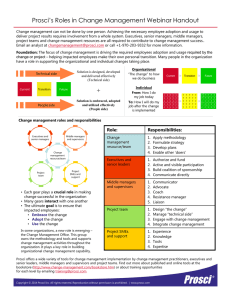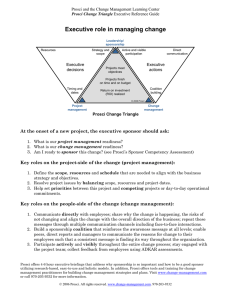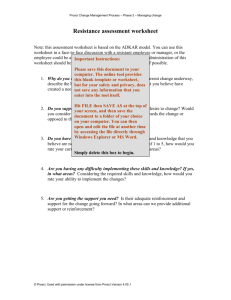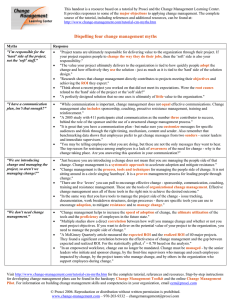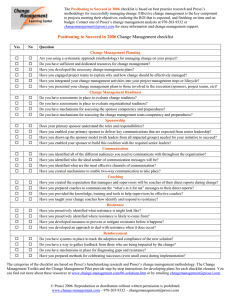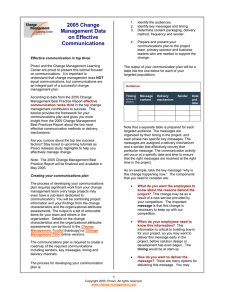Prosci’s Change Management Maturity Model™ Prosci © 2004.
advertisement
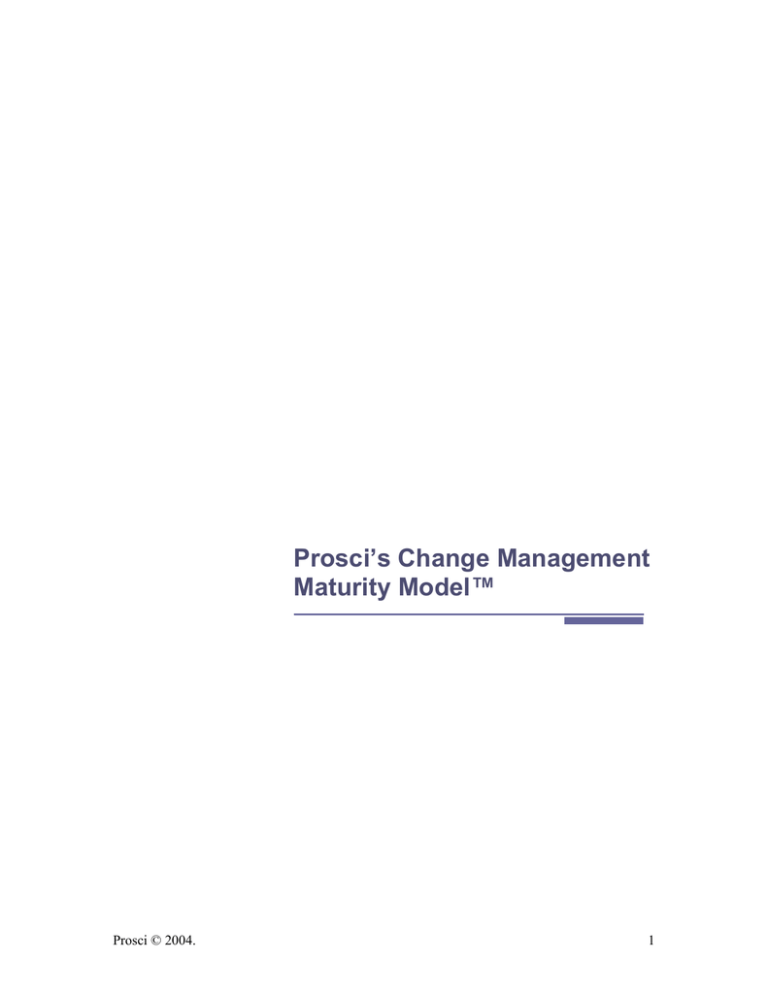
Prosci’s Change Management Maturity Model™ Prosci © 2004. 1 Introduction Organizations are facing larger and more frequent changes in the current economic climate. A changing marketplace, empowered workforce and technological advancements have created an environment where change is becoming ‘business as usual.’ In this environment, organizations are beginning to recognize the importance of building the competency to rapidly and successfully change. Prosci’s Change Management Maturity Model is based on benchmarking research and interactions with companies going through change. In March 2004, a study was completed to understand the usefulness of such a model and where organizations ranked their current competency level. While nearly 85% of the 160 companies placed themselves Level 3 or lower, we found a broad spectrum of change management capabilities – from none at all, to wide-spread organizational competence. Prosci’s Change Management Maturity Model describes the varying levels of change management capability across organizations. The maturity model has five levels or stages, from no change management to organizational competency. Each level involves more attention and management of the people side of change. Research shows that a ‘one-size-fits-all’ approach does not work when managing change, since each change and each impacted group is different. However, a common methodology that is built on situational awareness and customization allows the entire organization to move towards Level 4 or Level 5 while retaining the flexibility for individual groups and departments. The following pages contain a more detailed explanation of each level as well as the action steps your organization can take to move to the next level of the model. Prosci Change Management Maturity Model Level 5 Organizational Competency Change management competency is evident in all levels of the organization and is part of the organization’s intellectual property and competitive edge Continuous process improvement in place Level 4 Organizational Standards Organization-wide standards and methods are broadly deployed for managing and leading change Selection of common approach Level 3 Multiple Projects Comprehensive approach for managing change is being applied in multiple projects Examples of best practices evident Level 2 Isolated Projects Some elements of change management are being applied in isolated projects Many different tactics used inconsistently Level 1 Adhoc or Absent Little or no change management applied People-dependent without any formal practices or plans Highest profitability and responsiveness Highest rate of project failure, turnover and productivity loss © Prosci. Prosci © 2004. 2 Level 1 – Ad hoc or Absent Description At Level 1 of the maturity model, project teams are not aware of and do not consider change management as a formal approach for managing the people side of change. Projects at this level can have one or more of the following characteristics: Project leadership is focused only on the “concrete” or tangible aspects of the project including funding, schedule, issue tracking and resource management. Communications from the project are on a ‘need to know’ basis only and typically infrequent. Employees find out about the change first through rumors and gossip rather than structured presentations. Executive support is in the background as evident through funding authorization and resource allocation, but active and visible sponsorship is not present. Supervisors and managers have little or no information about the change, and have no change management skills to coach their employees through the change process. Employees react to change with surprise; resistance can be widespread. Productivity slows and turnover increases as the change nears full implementation. When is change management used on a project at this level? Change management is applied on a project at this level only as a last resort when employee resistance jeopardizes the success of the project. Level of integration between project management and change management At this level, change management is reactive and an add-on to the project. No integration with project management takes place at the beginning of the project. Steps for moving to Level 2 Step 1 Attend change management training, purchase change management resources or engage change management consultants. Step 2 Apply change management to isolated projects and use change management techniques to help projects that are currently experiencing resistance to change. Note: to move to level three, see Steps for moving to Level 3 Prosci © 2004. 3 Level 2 – Isolated Projects Description In Level 2, elements of change management begin to emerge in isolated parts of the organization. The effort to manage the people side of change is infrequent and is not centralized. Characteristics of this level are: A large variation of change management practices exists between projects with many different change management approaches applied sporadically throughout the organization; some projects may be effectively managing change while others are still in Level 1. Elements of communication planning are evident, but there is little sponsorship or coaching as part of change management. Managers and supervisors have no formal change management training to coach their employees through the change process. Change management is typically used in response to a negative event. Little interaction occurs between the isolated project teams using change management; each new project “re-learns” the basic change management skills. When is change management used on a project? Change management is applied on a project when resistance emerges or when the project nears implementation with only isolated projects using change management at the beginning of their project. Some elements of communication planning occur early in the lifecycle. Level of integration between project management and change management In Level 2, change management is not fully integrated into project management. On projects that use change management, the project team is aware and knowledgeable of change management. In certain instances, a change management advocate can encourage the integration of change management and project management. Steps for moving to Level 3 Step 1 Create knowledge about the different change management initiatives being used in the organization and begin research in change management best practices. Step 2 Create clusters of project teams applying change management principles. Begin collection of knowledge and tools across the organization. Step 3 Celebrate change management successes. Step 4 Begin building support for using change management with executives and senior leaders who oversee multiple projects. Prosci © 2004. 4 Level 3 – Multiple Projects Description At Level 3, groups emerge that begin using a structured change management process. Change management is still localized to particular teams or areas in the organization. Organizations at this level can have one or more of the following characteristics: Structured change management processes are being used across multiple projects; multiple approaches and methodologies are being utilized. Some elements of knowledge sharing emerge between teams in the organization; experiences are shared between teams in some departments or divisions. While change management is applied more frequently, no organizational standards or requirements exist; pockets of excellence in change management co-exist with projects that use no change management. Senior leadership takes on a more active role in sponsoring change and consider this role part of their responsibilities, but no formal company-wide program exists to train project leaders, managers or coaches on change management. Training and tools become available to project leaders and team members; managers are provided with training and tools to coach front-line employees in future changes. When is change management used on a project? Change management is initiated at the start of some projects, with a large fraction still applying change management as a reaction to employee resistance during implementation. Level of integration between project management and change management In Level 3, teams who are successful at change management integrate change management with their overall project management methodology at the inception of the project. Communication planning is integrated at the planning phase, and other plans are developed prior to implementation. Steps for moving to Level 4 Step 1 Enlist executive support for applying change management on every project and for building change competencies at every level in the organization. Step 2 Select a common methodology that can be used throughout the organization. Begin acquiring the tools and training necessary to rollout the common methodology. Prosci © 2004. 5 Level 4 – Organizational Standards Description In Level 4, the organization has selected a common approach and implemented standards for using change management on every new project or change. Note: a common methodology does not mean a ‘one-size-fits-all’ recipe – effective methodologies use repeatable steps but are built on understanding the situation and using the appropriate tools for the specific change. Organizations at this level can have one or more of the following characteristics: There is an enterprise-wide acknowledgement of what change management is and why it is important to project success. A common change management methodology has been selected and plans are developed for introducing the methodology into the organization. Training and tools are available for executives, project teams, change leaders, managers and supervisors. Managers and supervisors are provided formal training in change management. A functional group may be created to support change initiatives, with roles like ‘Director of Change Management’; organizations create a ‘center of excellence’ – individuals, groups or administrative positions dedicated to supporting change management efforts and building change management skills. Executives assume the role of change sponsors on every new project and are active and visible sponsors of change. Resistance and non-compliance is expected in isolated instances. Some project teams still do not understand why they are using change management. Adoption is not yet at 100% and the organization is in the process of building change management skills throughout the organization. When is change management used on a project? At Level 4 teams regularly use a change management approach from the beginning of their project. Change management work begins at the planning phase of the project. Level of integration between project management and change management Project management and change management are integrated from the beginning, to the point where they are not separable. Project teams follow both project and change management milestones. Steps for moving to Level 5 Step 1 Create a formal position or staff group that is responsible for the effective deployment, training and improvement of change management competencies. Step 2 Correct non-compliance. Analyze gaps in the organization that are not applying the selected methodology and develop plans to implement improvements. Prosci © 2004. 6 Level 5 – Organizational Competency Description Level 5 is having change management competency as part of the skill set of the organization. Organizations at this level can have one or more of the following characteristics: Effectively managing change is an explicitly stated strategic goal, and executives have made this a priority. Employees across the enterprise understand change management, why it is important to project success and how they play a role in making change successful. Change management is second nature – it is so commonplace that it is nearly inseparable from the initiatives. Managers and supervisors routinely use change management techniques to help support a broad range of initiatives from strategy changes to individual employee improvement. The organization gathers data to enable continuous improvements to the common change management methodology, tools, and training. Extensive training exists at all levels of the organization. Higher ROI, lower productivity loss and less employee resistance are evident across the organization. When and how is change management used on a project? Change management begins before projects begin. Level of integration between project management and change management When organizations have developed a high level of change management competency, change management steps are completely integrated into project management. Planning and design phases have both project and change management elements and are viewed as standard practice. Prosci © 2004. 7 Appendix - Results from the Maturity Model benchmarking study One hundred and eighty (180) individuals participated in the CM Maturity Model study. Individuals commented on where they were in the model, where they would like to see themselves, and how the model would be helpful. Current model level and goal model level Analysis was conducted to measure the gap between a participant’s current level and their goal level. 70% indicated they would like to move up two levels or more in the model. How would the model be useful 60% Current Goal 50% Percent of respondent Participants overwhelmingly identified themselves in the lower three levels of the Maturity Model. Only 16% felt that they were a Level 4 or 5. The average competency level was “2.4.” When asked what level was their goal, over 50% of participants indicated Level 5, and a full 80% indicated either Level 4 or Level 5. Participants location in the maturity model 40% 30% 20% 10% 0% Level 1 Level 2 Level 3 Level 4 Level 5 Level Participants commented on how the model would be useful in their organization. 90% of participants stated that the model would be useful or very useful. The most frequent uses for the model were: • • • • • • • Communication tool in organization – the model is useful for communicating with individuals throughout the organization, from executives to change management practitioners about where we are today and where we need to be in the future. Framework for building change management program. Support mechanism for continuous improvement efforts. Tool for talking with executives – the model demonstrates to leaders the importance of change management, their role as a sponsor and the need for necessary resource allocation to deal with the people-side of change – “Discussing the [CM] maturity model with senior management and executives begins the dialog for improvement.” Systematic tool for consistent change management application – the structured approach of the CM Maturity Model would provide organizations with a way to standardize change management throughout the organization. Strategic tool supporting organization’s goals – most organizations are facing larger and more frequent changes than ever before. Executive communication tool – beyond convincing leaders of the importance of change management, the model can be used to present leaders with an actionable model for implanting change management throughout an organization “The model would help provide a framework for executives and/or for the change agents. Prosci © 2004. 8
